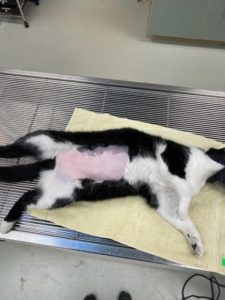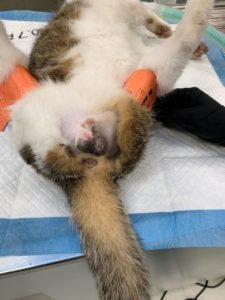TNR is the only scientifically proven way to reduce the overpopulation of cats, and as a bonus it is safe and humane. However, when TNR surgery is performed in the winter, there are safety concerns that must be addressed to make sure we aren’t hurting the cats we are trying to help.
When cats undergo TNR surgery to be sterilized and vaccinated they have their bellies shaved, females more than males, but both have a bare spot that can get wet/cold and lead to suffering, frost bite, or even fatalities in cold weather.


For domestic short haired cats to regrow their fur, it usually takes about 2-3 months! Long haired cats can take as long as 6 months! 2-3 months might sound like a long time. But don’t worry, there are many things that can be done to prevent them from getting cold and wet, even in the snow.
One of the best ways to keep a cat safe in the colder months after TNR is to ensure they have a dry shelter. Examples of safe, dry shelters include many things from a garage, to a barn, to a shed, to a dog house. Do NOT use blankets or anything that retains water and freezes. Shelters will need a roof, walls (preferably insulated), and a straw bedding/floor. The purpose of the straw floor is to elevate the cats off the ground and also to provide a non-porous material so the bedding will not get wet and freeze.
If you find that cats are not using a provided shelter sometimes sprinkling catnip, treats, or silver vine can be a good way to entice them in. Providing more than 1 type of shelter is an additional step that can be taken to ensure the cats will have a shielded place to recover from TNR. Once they have recovered and their fur regrown, it will be time for spring and for them to romp the land! Any questions or concerns regarding safe shelters please reach out to tnr@hshv.org .
At HSHV, we take the safety and wellbeing of our TNR friends very, very seriously. This is why, unless you sign a document ensuring you have shelter for your cats, we will not perform TNR for them during the cold months, usually between mid-November and mid-March.



